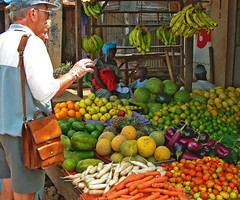 |
| Gambia: Economy at risk - Tourists shopping in Kololi Market, The Gambia (Photo credit: Anguskirk) |
Gambia’s real gross domestic product, GDP (the total value of goods and
services that the country produces in a year) grew by an estimated 4 percent in
2012, led by a partial rebound in crop production and strength in the tourism
sector, IMF’s mission chief David Dunn said on April 10, 2013.
“Inflation remained under control, ending the year at just under 5
percent, despite the depreciation of the Gambian dalasi during the second half
of the year,” he said. “A substantial overrun in government spending late in
the year resulted in higher-than-budgeted domestic borrowing, 3½ percent of
GDP.”
However, Dunn said real GDP growth is expected to accelerate if the
recovery in crop production is sustained. Also, by accessing new markets, the
potential for growth in tourism looks good.
 |
| Gambia: Economy at risk - fish smoking oven (Photo credit: Anguskirk) |
Inflation has picked up partly due to side effects from the introduction
of the value-added tax (VAT) at the beginning of the year.
“Although the VAT is applied to firms with a turnover of at least one
million dalasis, we understand that many smaller businesses also raised their
prices opportunistically,” Dunn said.
The IMF observed that during the first quarter of 2013, The Gambia Government
spending once again exceeded planned allocations, contributing to an uptick in
Treasury-bill yields. Correspondingly high bank lending rates are discouraging
private sector borrowing.
Tightened fiscal policy
The mission welcomes the Government’s decision to tighten fiscal policy
by reducing its domestic borrowing needs to 1½ percent of GDP in 2013 and then
to ½ percent of GDP a year or less, beginning in 2014.
This, the mission said, will help lower the heavy domestic debt burden.
They also welcome the intention of the Government to submit a fully-funded
supplementary budget to the National Assembly later this month.
The money lending agency noted that targets for reserve and broad money
growth have been tightened to stem potential inflationary pressures and
stabilize the dalasi, which has continued to weaken against most major
currencies.
IMF supported the target of the Large Taxpayers Unit of the Gambia
Revenue Authority (GRA) to achieve 100 percent compliance with taxpayers’
income tax filings in the current year, to help broaden the tax base.
“This is necessary if business-friendly tax reforms such as a reduction
in tax rates are to be considered in the future,” it said. “The mission also
welcomed efforts by the GRA to strengthen its audit functions.”
 |
| Landing a fishing boat in The Gambia (Photo credit: Anguskirk) |
The IMF mission that visited The Gambia from April 4-10, 2013, concluded
discussions on the first review of the authorities’ macroeconomic and financial
programme that is supported by the IMF under its Extended Credit Facility
(ECF).
“The mission reached an agreement, and referendum, on programme targets
for 2013. The IMF Executive Board would consider the completion of the review
by end-May 2013,” the Briton Woods institution said in a statement.
Written by Modou S. Joof
Follow on Facebook: The-North-Bank-Evening-Standard











No comments:
Post a Comment
The views expressed in this section are the authors' own. It does not represent The North Bank Evening Standard (TNBES)'s editorial policy. Also, TNBES is not responsible for content on external links.